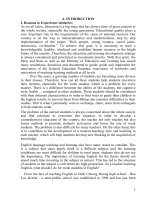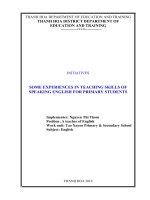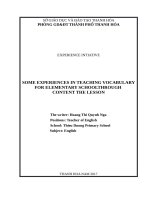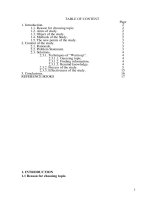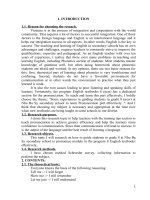Some experiences in helping pupils do projects while teaching
Bạn đang xem bản rút gọn của tài liệu. Xem và tải ngay bản đầy đủ của tài liệu tại đây (3.45 MB, 28 trang )
INDEX
Order
number
Content
Page
1
1. INTRODUCTION:
1
2
2. RESOLVING THE PROBLEMS.
2
3
2. 1. Theoretical basic of the problems
2
4
2.2. The problem state before the application of
experience
3
5
2.3. The measures carried out to solve the
problem.
4
6
2.4. The effectiveness of the experience initiative
for educational activities, teachers, colleagues and
the schools
18
7
III. Conclusion
19
1. INTRODUCTION:
1.1. Reason for choosing the topic:
English is an international language that is used as the official language
of more than 53 countries and territories, used as the second language of more
than one billion people in the world. Therefore, English is a special language
that contributes to the development of the ability of all countries and help the
people understand and move closer together. In line with the evolution of the 4.0
revolution, the English development strategy has become an inevitable part of
the human strategy, a strategy for the future of every nation.
The strategic objectives of foreign languages are closely linked to the
major goals of education and training, which are defined in three aspects: raising
the people's knowledge, training human resources and fostering talents. Foreign
languages in general and English in particular have important roles and positions
in the education and training and in the development of the country. It also poses
challenges for educators to create innovative ways to make English become the
communication tool of the whole society.
Project teaching has many benefits for both teachers and students. More
and more theoretical studies support the application of school-based project
teaching to encourage students to reduce dropouts, promote collaborative
learning skills, and improve academic performance.
Project-based learning is a new element in the English program for
elementary students. There are no researches papers on this subject so my
colleagues and schools have not experienced to resolved, overcome.
Project teaching is a form of teaching or a combination of teaching
methods, which, under the guidance of teachers, learners acquire knowledge and
form skills through solving a project in real life, followed closely by the
curriculum, with the combination of theory and practice and the creation of
specific products.
For the above reasons, I have studied and extracted some experiences in
the teaching process into the topic: Some experience in helping pupils do
projects at some primary school in Cam Thuy District.
1.2. Research purposes:
Starting from the above reasons, the topic should concentrate in the
following tasks:
The purpose of this research is to study the current status of foreign
language teaching for elementary school pupils and the foreign language
learning of primary pupils, their excitement towards their study subjects and
their foreign language learning methods.
2
Find out the strengths and weaknesses in the methodology, as well as in
teaching projects of teachers, and then propose solutions to improve the quality
of foreign language at primary school.
Research the basis of science and practical basis of teaching and
learning English in primary school. Study the cause of the situation. Adjust the
direction of innovation teaching and learning methods.
Improve the quality of teaching and learning through projects.
Determine the effectiveness and impact of stimulating learning English for
primary students through projects.
1.3. Research subjects:
Object of study is how to help pupils do projects in some primary
schools in Cam Thuy District.
1.4. Research Methods
In this topic, I have used the following research methods:
Theoretical research methodology: Read a number of books, reference
materials, and online literature related to the projects in the class.
Survey observation: To investigate the topic deeply, I investigated the
current status of teaching and learning English in primary school, the interest of
students in the subject. Interviews and tutorials for the English team, combined
with a team of specialists and school administrators.
Experimental Methods: I have been guiding pupils through projects
related to the content of the unit.
Method of summarizing and drawing experience: After each period of
teaching using the form of teaching in the topic, I often summarize, draw
experience from each period, continue to change, renovate suitable in the
following lessons. After each period, I have also compared, summed up to draw
common experience.
2. RESOLVING THE PROBLEMS.
2.1. Theoretical basic of the problems.
Teaching projects contributes to renovating teaching methods, changing
training methods. Teaching projects transfer from "speaking teacher" to "student
do". Learners become problem solvers, decision makers, not passive listeners.
They collaborate in groups, organize activities, conduct research, solve
problems, synthesize information, organize time and reflect on their learning.
Teaching the project facilitates a variety of learning styles, using information
from different subjects. It helps learners with the same content but can perform
in different ways. Project teaching requires positive thinking to solve problems,
stimulate motivation, stimulation learning. Project teaching encourages the use
3
of higher-order thinking skills, which helps learners to better understand the
learning content. Teaching the project is an important way to implement the
method of training human beings to develop comprehensively, learning along
with the practice, combining study and scientific research.
Project teaching creates a favorable environment for learners to practice
and develop. Teaching the project helps learners learn more because in most
projects, trainees have to do exercises related to many fields. Every student has
the opportunity to work because the learning task is accessible to everyone.
Students have the opportunity to try out their own abilities when participating in
a project. Students are capable of thinking deeply when encountering complex
problems. Participants have the opportunity to explore, evaluate, explain and
synthesize information. Students are allowed to apply what they have learned,
especially knowledge about science and technology. When designing the outline
for the project, the learner must imagine, outline the plans and action plans, so
their imagination and their creativity are trained and developed. Develop
evaluation capacity. Project teaching requires a variety of forms and
assessments, including teacher evaluations, student evaluations, self-assessment
and feedback. Students have the opportunity to choose and control their own
learning, as well as the opportunity to collaborate with classmates to increase
their interest in learning. Project teaching helps students to be more confident
when they graduate because they develop the necessary life skills: the ability to
make accurate decisions; ability to solve complex problems; ability to work well
with others; active, flexible and creative.
Teaching the project promote pupils positive, self-reliant, active and
creative. They are the centers of project teaching, from the passive position to
active, so teaching the project has created conditions, while forcing students to
work more actively. Project teaching allows learners more autonomy in their
work, from planning to implement projects, creating products. As a result, the
project teaches self-reliance, self-reliance, responsibility, creativity and ability to
solve problems of learners.
Project teaching helps learners develop communication skills. Teaching
projects not only help learners acquire knowledge, but also help them improve
their ability to cooperate, ability to communicate with others. Teaching the
project promotes collaboration between students and teachers, between learners,
and sometimes extends to the community.
2.2. The problem state before the application of experience
Project is a new part in English textbook that project itself causes
difficulties for teachers when have been applied in the schools.
Teaching the project requires a lot of time. This is the biggest obstacle,
if time is not allocated or the teacher has no flexibility, then the performers must
4
work overtime. This explains why a teaching method has many advantages such
as teaching the project is difficult to put into practice in our country.
It is not possible to apply rampant school teaching but can only apply to
certain contents under the conditions allowed. Project teaching can not substitute
lecture methods in the transmission of theoretical knowledge or information
dissemination. Project teaching is difficult to apply in primary schools.
Teaching the project requires careful preparation and planning to attract
learners actively. Practical and practical activities when teaching the project
requires appropriate material and financial means.
Moreover, most of schools in Cam Thuy District have been lacking of
teaching aids, especially we do not have any laboratories and function rooms.
Some areas in my town, especially fishing villages, the lives of the
children are difficult and hard, so students have not been given much attention to
the study by their family.
English is a new subject and most of the members of my students' families
hard know anything about the language, so most of the students only use English
at school.
Beside, most students have little or no opportunity to communicate with
people from English-speaking countries. It is clear that they have been lack of
the natural environment to learn English pronunciation.
Besides, the time allowed for learning English in class may make many
students lack both the natural environment and the creative environment to
practice and improve English skills.
2.3. The measures carried out to solve the problem.
Because pupils are the center of teaching, teaching the project should
pay attention to the needs and interests of the pupils: the learners are directly
involved in choosing topics and learning contents suitable to the ability and
excitement of the pupils. Project teaching is an important teaching method for
implementing student-centered teaching views. Pupils actively and reliably
participate in various stages of the teaching process, from goal setting, planning
to project implementation, testing, adjustment, evaluation and presentation.
Teachers mainly play the role of adviser encourage positive, self-reliant,
responsible, creativity of learners. Learners do not just listen, repeat and
remember they also need to collect information from many different sources
then analyze, evaluate and draw their knowledge. Learners not only acquire
knowledge about events but also apply the theory into reality, practice problem
solving skills.
A project is taught through the practical activities are consistent with the
ability of the learners, for this reason, teachers should plan rich and diverse
5
learning activities. Teachers should focus on the core learning content, the core
of the program. The content of the project is a combination of knowledge of
different fields or subjects to solve a problem is really challenging. The project
is interdisciplinary, meaning that many subjects are linked. A project also
requires knowledge of other subjects and social skills that pupils need to work
together.
Teachers should combine teamwork and personal work while guiding
pupils do projects. Projects are usually conducted in groups, including the
assignment and collaboration among members. Teamwork helps make the
product more quality, less time consuming because it combines and promotes
the individuality of the individual. Projects require collaboration skills between
members, students and teachers as well as with other social forces participating
in the project. As a result, activities in project teaching are highly social.
Teachers should be interested in the product of the activity. The project
has varied and regular forms of evaluation. Teachers and learners should
evaluate the products. The results of the project are expressed crystallized in the
product of the learner. From the time of project implementation, expected results
have to be clarified and reviewed repeatedly. Learners are able to demonstrate
their knowledge through reports and products. Through products, teacher should
praise pupils and motivate them learning better.
Here are some examples I have been applying while teaching projects in
some primary schools in Cam Thuy District:
2.3.1. Class 4: Unit 8: What subjects do you have today?
Project: Ask a friend in another school about his/ her timetable and stick the
table. Then tell the class about it.
Procedure:
- Tell pupils that they are going to interview a friend in another school about his/
her timetable and tell the class about it.
- Guide pupils to do the task:
+ First, ask a friend in another school questions:
What subjects do you have on Monday/ Tuesday/ Wednesday/ Thursday/ Friday?
I have……………………
+ Complete the timetable.
+ Prepare to talk: For example, This is my friends’ timetable. Her/ His name
is…... She/ He is a pupil at ……..Primary School. She/ He has…………..on
Monday…...
- Ask pupils to do the task at home and bring their friend’s timetable.
6
- Have them tell their class about their friends’ timetables in the next lesson.
- Ask other pupils to give their comments about their friends’ products.
- Select the best three products and who have best presentations, then award the
pupils with small prizes to motivate them.
Pupil’s products
2.3.2. Class 4: Unit 15: When’s Children’s Day?
Project: Make a greeting card for Tet. Then write wishes to your friend.
Procedure:
- Tell the pupils about the project. They should make a greeting card for Tet and
write wishes to your friend. Explain the task clearly and check understanding.
- Ask them to draw the cards for Tet. After decorating the cards, they should
copy the text from the book and fill in the information.
- Give them time to do the task during the lesson or ask them to do it at home if
there is not enough time. Tell pupils that they will be invited to give a
presentation of their work in the next class.
- Ask pupils to display swap their cards in pairs.
- Ask some students to show their cards and say aloud what they have written.
7
- Select the best three cards and who have best presentations and award the
pupils with small prizes.
Pupil’s cards
2.3.3. Class 4: Unit 17: How much is the T-shirt?
Projects: Make four flashcards of clothes. Draw a picture of clothing item
on one side of the card and write the word for it on the other side. Then
practice with your partners.
Procedure:
- Tell pupils that they are going to make four flashcards of clothes.
- Give each pupil four cards, explain the task clearly ( students should draw a
picture of clothing item on one side of the card and write the word for it on the
other side, then they should show the flashcards in pairs and talk about them)
and check understanding.
- Give them time to do the task during the lesson or ask them to do it at home if
there is not enough time. Tell pupils that they will be invited to give a
presentation of their work in the next class.
8
- Select the best three flashcards and who have best presentations and award the
pupils with small prizes.
Flashcards of pupils
2.3.4. Class 5: Unit 2 : I always get up early. How about you ?
Project: Interview two of your classmates about their daily routines.
Procedure:
- Tell pupils that they are going to interview their classmates about their daily
routines and report the results to the class.
- Model an interview :
+ Ask the questions :
What do you do in the mornong/ afternoon/ evening? – I always/ often.....
How often do you..........? – Once/ Twice a day/ week...
+ Report the results of the interview : Here are the results of my interview.
Huyen often goes to school early in the morning....................
9
- Set a time limit for them to interview their classmates and take notes.
- Ask a few pupils to report the results of their interviews to class. Select who
have best presentations and award the pupils with small prizes.
Pupils are interviewing their friends.
2.3.5. Class 5: Unit 6 : How many lessons do you have today?
Project : Write a letter to a pen friend to talk about your timetable.
Procedure:
- Tell the class about the project and how to carry it by saying : In this project,
you are going to write a letter to a pen friend to talk about your timetable.
- Have pupils work in pairs to discuss what are they going to write in the letters.
- Give students time to do the task independently. Go around and offer for help
if necessary.
- Get students to swap their letter to correct their friends’ mistakes.
10
- Ask some pupils to show their letter and read aloud.
- Select who have best letters and award the pupils with small prizes.
A letter of a student
11
A letter of a student
2.3.6. Class 5: Unit 9: What did you see at the zoo?
Project: Draw your dream zoo.
Procedure:
- Tell the class that they are going to draw their dream zoos.
- Ask them to work in groups of five to discuss what animals to put in their dream
zoos.
- Set a time limit for them to do the task independently.
Pupils’ drawings
12
- Get students to show their pictures with their partners and talk to him or her.
- Have the class display their drawings. Invite some students to talk to the class
about their dream zoos.
- Select the best three pictures and who have best presentations and award the
pupils with small prizes.
Pupils are talking about their dream zoo.
Pupils are talking about their dream zoo.
2.3.7. Class 5: Unit 11: What’s the matter with you?
Project: Talk about two health problems and give advice.
Procedure:
- Tell pupils that they are going to talk about two health problems and give
advice in pairs.
13
- Guide pupils how to do the project: Choose two health problems, then give
advices (for example, toothache…….should go to the dentist/ brush your teeth
regularly/ shouldn’t eat a lot of sweets or sugary products,….).
- Give pupils time to do the task in pairs.
Pupils are talking with their partners.
- Prepare some posters or draw some simple pictures for students to talk.
- Have some pupils to talk in front of the class.
14
A pupil is talking on the board.
- Ask other pupils to give their comments about their friends’ talking.
- Select who have best presentations, then award the pupils with small prizes to
motivate them.
2.3.8. Class 5: Unit 12: Don’t ride your bike too fast!
Project: Make a poster about home accidents and how to avoid them.
Procedure:
- Tell the class that they are going to make a poster about accidents at home and
how to avoid them.
- Have them work in groups. They should decide which accidents to select and
discuss how to avoid them.
- Set a time limit for them to do the task.
- Select a few groups to present the results of their discussions.
- If there is not enough time, give the project as homework.
- Select the best three posters and presentations to award the pupils with small
prizes.
15
Pupils’ posters
2.3.9. Unit 17: What would you like to eat?
Put foods and drinks into two groups: very healthy and not very healthy.
Procedure:
- Tell the class that they are going to put foods and drinks into two groups: very
healthy and not very healthy.
- Have the pupils do the task in groups of four to put foods and drinks into two
groups: very healthy and not very healthy. Set a time limit for them to do the
task.
- Select a few groups to present the results of their discussions. Then vote the
groups that have best products and good presentation to award the pupils with
small prizes.
Pupils are doing the project in groups of four.
16
A product of a group.
2.3.10. Class 5: Unit 14 : What happened in the story ?
Project: Tell a story.
Procedure:
- Tell the class that they are going to tell a story in groups of four and say what
they think of the character.
- Have them think about a story and divide the characters and the narrator and
commentator.
- Set a time limit for them to do the task.
- Select a few groups to present their story.
- Have pupils vote the best groups that have best telling stories and award the
pupils with small prizes.
17
A group is telling a story
2.3.11. Class 5: Unit 15: What would you like to be in the future?
Project: Make a poster about what you would like to be in the future and
tell the class about it.
Procedure:
- Tell the class that they are going to make a poster about what you would like to
be in the future and tell the class about it.
- Guide them how to do the project.
- Set a time limit for them to do the task independently.
- Get students to show their posters with their partners and talk to him or her.
- Have the class display their posters. Invite some students to talk to the class about
what you would like to be in the future.
18
- Select the best three posters and who have best presentations and award the
pupils with small prizes.
2.3.12. Class 5: Unit 15: Which place would you like to visit?
Project: Find a place of your favourite place. Show it to the class and talk
about it.
Procedure:
- Tell the class that they are going to find a place of your favourite place. Show
it to the class and talk about it.
- Guide the pupils to do the project:
+ Ask them: Where would you like to visit …?- I’d like to visit….
+ Find the place at home and show it to the class the next lesson.
+ Prepare to talk by answering the questions:
What is your favourite place?
When did you go there?
What did you do there?
What do you think of it?
19
- Select a few pupils to show their favourite places and talk.
- Have pupils vote the best talking and award the pupils with small prizes.
A pupil is talking about her favourite place
A pupil is talking about her favourite place
2.4. The effectiveness of the experience initiative for educational activities,
teachers, colleagues and the schools
a. Educational activities
In the school year 2017 – 2018, I was assigned to teach English in two
primary schools in Cam Thuy District, I found the difficulties and disadvantages
20
as I have mentioned at the reality of the problem. I have conducted surveys and
had the following results:
Grade
Numbers of
pupils
Incomplete
Complete
Well completed
5
157
5
107
45
After conducting the solution as above while teaching English for pupils,
pupils are interested in learning English more. They are more exciting and
confident in speaking, listening as well as using English. Besides, they can
communicate in English well. They have a positive change and praiseworthy.
The pupils' learning results are improving significantly. Students are more
enthusiastic, excited, actively in learning, careful preparation at home and more
attentive at class. As a result, the quality of English learners' performance at the
end of the first semester has improved markedly.
Grade
Numbers of
pupils
Incomplete
Complete
Well completed
5
157
0
47
111
The results show that students not only catch the knowledge content but
also broader, deeper understanding of many issues. They have self-discovery
and resolution problems in content knowledge. Their ability to live is enhanced
teamwork skills, well communicative abilities and methods of handling
situations.
Especially, with the knowledge provided by the new teaching method,
pupils will easily apply in the real life, changing quite a lot of their perceptions,
thoughts, emotions and attitudes towards the desire to make their lives become
better, more human.
b. For teachers, colleagues and the schools
Projects occur at the end of all units, they help teachers reinforce what
students have learnt. When the teacher presents the project, pupils are very
excited and excited to discuss, give their opinions to complete the project. They
are very positive, enthusiastic to participate in the project, boldly, enthusiastic,
and boldly presented the results, anxiety waiting for the evaluation of the teacher
and their friends. In particular, they are very interested in expanding their
knowledge; They love English more because it is more practical for life ... Each
lesson passes quietly, comfortable but still effective with both teachers and
pupils.
3. CONCLUSION AND RECOMMEND
3.1. Conclusion
21
Looking at the results of the survey at the end of the first semester of the
pupils in grade 5 reflects the sharp increase in the rate of well-completed pupils,
the average incomplete and complete pupils decline gradually, contributing to
the improvement of the quality of teaching English. This demonstrates the
application of the " Some experience in helping pupils do projects at some
primary school in Cam Thuy District " is very effective. If teachers are willing
to invest time and enthusiasm, I firmly believe that the level of primary school
pupils in the district will be significantly improved, which will help them to be
confident in using English in real life. Learn English now is more plentiful to
meet the needs of students.
3.2. Recommend.
To conference school, local authorities concerned to facilitate investment
in equipment, teaching aids, buy the pictures for English subjects.
Recommended prevention education institutions Cam Thuy District the
contest pictures in teaching teachers to evoke creativity to help schools get the
pictures of a rich and varied, in order to increase students’ interest in leaning
English Subject.
English lessons are always so noisy that affect the teaching and learning
of the next class. Therefore, I beseech People's Committee, Cam Thuy
Education and Trainning Department and local government to create favorable
conditions for building a function room, as well as consider adding resources
data, pictures, radio to the teaching and learning of primary school teachers and
students a better day.
In the process of researching and applying initiative experience because
my experience in teaching elementary students is still limited, the teaching aids
are lack, while applying time is not very long; Although I fully agree, the
initiative is not really complete. So I would like to receive the comments of the
leaders, my colleagues to help supplement and improve my professional skills as
well as improve the efficiency and quality in teaching English better. Finally I
would like to thank!
Thanh Hoa, March 18th 2018
Certified by the principal
I swear this is the experience of its initiative to
write, do not copy other people’s content If it
is wrong, I will have my full responsibility.
Writer
Vu Thi Loan
22
LIST OF REFERENCES
1. English 4 - Students' book. - Vietnam education publishers.
2. English 5 - Students' book. - Vietnam education publishers.
3. English 4 - Teachers' book. - Vietnam education publishers.
4. English 5 - Teachers' book. - Vietnam education publishers.
5. Some positive teaching methods in primary. - Vietnam education publishers.
6. Psychological elementary age. - Vietnam education publishers.
7. Some active learning techniques in primary schools. - Vietnam education
publishers.
23
Lists of the experience of the author have been assessed by the Scientific
Council of the district, province from grade C to higher levels.
Research writer: VŨ THỊ LOAN
Position and Office address: Teacher of English at Cam Thuy
Town Primary School.
Order
Initiate Experience
Ranked by
Result
School Year
(A, B or C)
1.
Applying
some
positive
teaching methods in teaching
English at secondary schools.
district
C
2012-2013
2.
Some experience in correcting
" s-endings" pronunciations
while teaching English for the
students in grade 4 at Cam
Thuy Town Primary School.
province
C
2014-2015
24
COMMENTS BY THE MEMBERS OF SCIENCE COUNCIL
OF CAM THUY TOWN PRIMARY SCHOOL.
.................................................................................................................................
.................................................................................................................................
.................................................................................................................................
.................................................................................................................................
.................................................................................................................................
.................................................................................................................................
.................................................................................................................................
.................................................................................................................................
.................................................................................................................................
.................................................................................................................................
.................................................................................................................................
.................................................................................................................................
.................................................................................................................................
.................................................................................................................................
.................................................................................................................................
.................................................................................................................................
.................................................................................................................................
25
